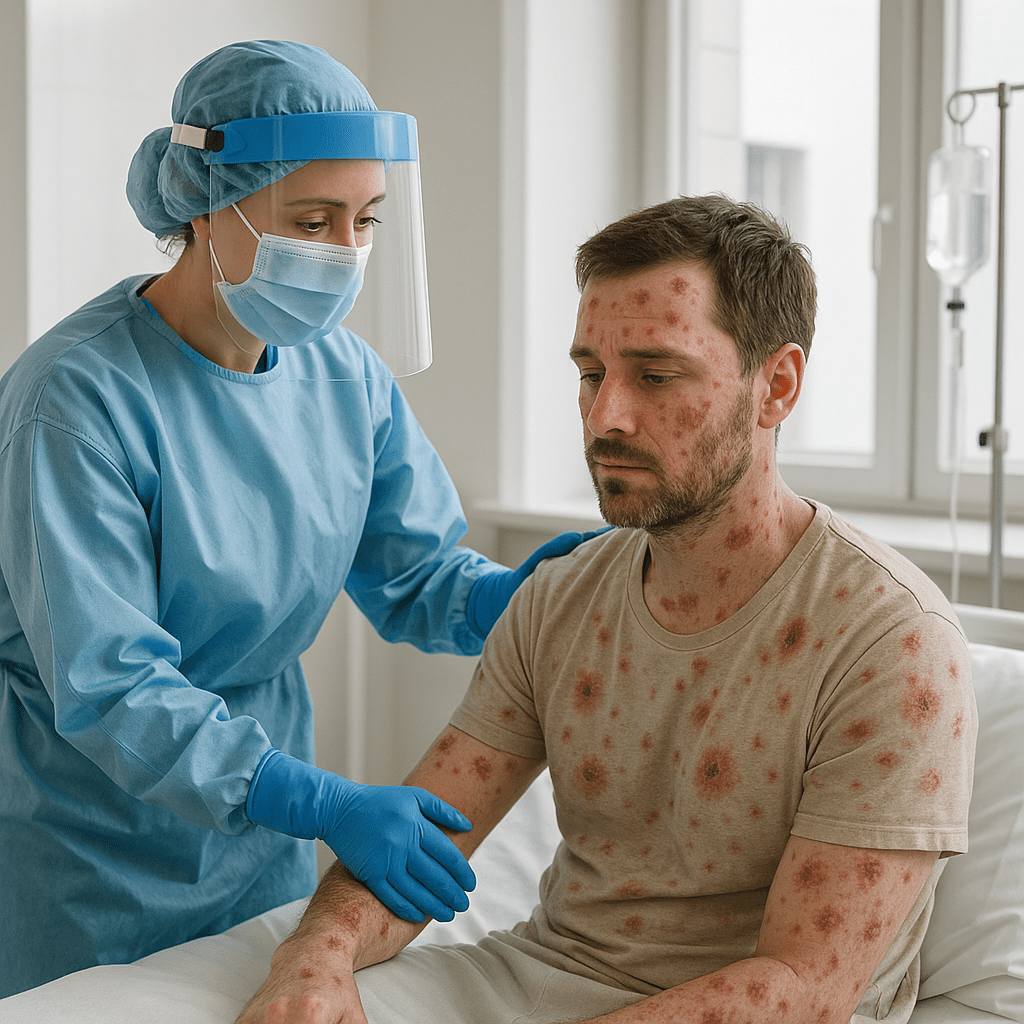Health officials have confirmed a locally acquired case of mpox (formerly monkeypox) involving the clade I strain, known for causing more severe illness. This is the first time this more virulent variant has been detected without travel history to Africa, raising new questions for nurses, public health officials, and the wider medical community.
As a registered nurse (RN), nursing student, or NCLEX candidate, understanding this development is essential for both clinical care and community education.
What Is the Clade I Mpox Strain?
Mpox is a viral infection related to smallpox but generally less deadly. Until recently, the clade II strain—responsible for the 2022 outbreak—was the dominant form in the U.S., producing relatively mild disease.
The clade I strain, however, has historically been associated with higher severity and complication rates, including longer-lasting lesions, pain, and secondary infections. Reports from Los Angeles County and other areas suggest that at least one patient with clade I infection had no international travel history, indicating local transmission.
Why Nurses Should Be Concerned
For nurses and RNs, this case underscores the importance of infection control, patient education, and public health awareness.
While the general public risk remains low, nurses are on the front lines of recognizing and reporting new or unusual disease patterns. Early detection, appropriate isolation, and preventive education can make a major difference in controlling future spread.
Clinical Features to Recognize
| Symptom | Typical Presentation | Nursing Notes |
|---|---|---|
| Fever & chills | Often first symptoms | Monitor for dehydration, fatigue |
| Lymphadenopathy | Swollen nodes (neck, groin) | Distinguishes mpox from similar rashes |
| Rash & lesions | Start as flat spots → pustules → scabs | Use contact precautions; cover lesions |
| Pain & malaise | Common with Clade I strain | Provide comfort measures and rest |
| Possible complications | Secondary infections, sepsis, pneumonia | Early recognition saves lives |
Nursing Care Priorities
1. Infection Control
- Apply contact and droplet precautions immediately when mpox is suspected.
- Use gloves, gowns, eye protection, and ensure proper waste disposal.
- Educate staff on correct donning and doffing of PPE.
2. Patient Assessment
- Ask about symptom onset, contact history, and vaccination status.
- Don’t assume travel is required for infection—consider local exposure.
- Monitor for respiratory symptoms, fever progression, and skin integrity.
3. Patient Education
- Explain how mpox spreads—direct contact with lesions, bodily fluids, or contaminated materials.
- Encourage avoiding close skin-to-skin contact and sharing linens or towels.
- Promote mpox vaccination for high-risk groups when available.
4. Reporting & Collaboration
- Report suspected cases to local health departments immediately.
- Collaborate with infection-control nurses and public-health officials for tracing and containment.
- Participate in continuing education programs or nursing bundles addressing emerging infections.
NCLEX-Level Focus: Key Nursing Concepts
NCLEX and nursing educators emphasize the following when studying infectious disease management:
- Isolation and transmission precautions
- Community health nursing and outbreak control
- Patient advocacy for stigmatized conditions
- Cultural competence in discussing sensitive infections
- Health promotion and vaccine education
By mastering these areas, future nurses will not only pass the NCLEX but also serve as vital protectors of public health.
Preventing Spread in Healthcare Settings
Nurses play an essential role in prevention and reassurance. Remind patients that mpox is a viral illness—not a moral failing—and reinforce that seeking care early prevents complications.
Hospital infection-control teams should also review current mpox protocols and update nursing bundles to reflect potential encounters with the more severe Clade I strain.
Final Thoughts for RNs and Nursing Students
The recent detection of a locally acquired Clade I mpox case shows how quickly public-health landscapes can change. For registered nurses, RN nurses, and nursing students, this is a reminder that constant learning, vigilance, and compassion remain central to professional nursing practice.
By staying informed and prepared, nurses continue to safeguard communities—one patient at a time
🩺 FAQ — Mpox Clade I and Nursing Care
The Clade I strain, also called the Central African lineage, is a more severe form of mpox. It can cause stronger symptoms, longer illness, and higher complication rates than the Clade II strain seen in the 2022 outbreak.
Mpox spreads through close physical contact with infectious lesions, body fluids, or contaminated materials (like bedding or clothing). It is not airborne like COVID-19 but can spread through prolonged face-to-face contact.
Nurses should isolate the patient, apply contact and droplet precautions, alert infection control, and notify public health authorities immediately. Proper PPE use is essential to prevent transmission.
Yes. Current mpox vaccines, such as JYNNEOS, offer cross-protection against multiple clades, including Clade I. Vaccination remains one of the best prevention tools for high-risk groups.
People with weakened immune systems, the elderly, children, and those with chronic illnesses are at increased risk of severe symptoms. Nurses should monitor these populations closely for complications.
Suggested External Link :
CBS News: Mpox Clade I Strain Confirmed

